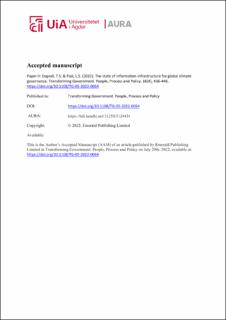| dc.contributor.author | Engvall, Tove Sofia | |
| dc.contributor.author | Flak, Leif Skiftenes | |
| dc.date.accessioned | 2024-04-02T10:26:16Z | |
| dc.date.available | 2024-04-02T10:26:16Z | |
| dc.date.created | 2022-09-29T09:49:44Z | |
| dc.date.issued | 2022 | |
| dc.identifier.citation | Engvall, T.S. & Flak, L.S. (2022). The state of information infrastructure for global climate governance. Transforming Government. People, Process and Policy, 16(4), 436-448. | en_US |
| dc.identifier.issn | 1750-6174 | |
| dc.identifier.uri | https://hdl.handle.net/11250/3124431 | |
| dc.description | Author's accepted manuscript | en_US |
| dc.description.abstract | Purpose The world is facing global challenges that require international collaboration. This study aims to describe and analyze how digital technologies are applied in global governance to respond to such critical challenges. Design/methodology/approach The authors apply an interpretive case study of climate reporting to the United Nations Framework Convention on Climate Change (UNFCCC) as a case of digitalization in global governance. It includes interviews with officials in the Swedish public administration and the UNFCCC secretariat to cover national and international levels. The authors describe the reporting process and analyze the role of information systems through the lens of information infrastructures. Findings “Information infrastructure” is a valuable instrument to understand digitalization in global governance as a complex interplay between information systems, information, standards, organizations, people and social structures. The level of sophistication is, however, basic with a large potential for improvement – for instance in analytical and communicative services to support evidence-based decision-making and assessment of progress. Research limitations/implications The data collection is limited to one governance process: reporting. Future studies should complement the findings by broadening the scope to other processes. The authors propose that digital global governance is dependent on an effective information infrastructure, and that the five design principles by Hanseth and Lyytinen (2016) offer guidance when developing this. Practical implications The results indicate a large unutilized potential of digital technologies to improve progress assessment, communicate more effectively with stakeholders and identify new ways of visualizing data to support decision making in global climate policy. Social implications Use of digital technologies, as suggested in the article, could strengthen the implementation capability of climate goals, which is of urgent need. Originality/value While most research in digital governance considers the national or municipal level, this study provides empirical insight and theorization of digital technologies in a global governance setting. | en_US |
| dc.language.iso | eng | en_US |
| dc.publisher | Emerald Group Publishing Limited | en_US |
| dc.rights.uri | http://creativecommons.org/licenses/by-nc/4.0/deed.no | |
| dc.title | The state of information infrastructure for global climate governance | en_US |
| dc.type | Peer reviewed | en_US |
| dc.type | Journal article | en_US |
| dc.description.version | acceptedVersion | en_US |
| dc.rights.holder | © 2022, Emerald Publishing Limited | en_US |
| dc.subject.nsi | VDP::Informasjons- og kommunikasjonssystemer: 321 | en_US |
| dc.subject.nsi | VDP::Information and communication systems: 321 | en_US |
| dc.source.pagenumber | 13 | en_US |
| dc.source.volume | 16 | en_US |
| dc.source.journal | Transforming Government: People, Process and Policy | en_US |
| dc.source.issue | 4 | en_US |
| dc.identifier.doi | https://doi.org/10.1108/TG-05-2022-0064 | |
| dc.identifier.cristin | 2056717 | |
| cristin.qualitycode | 1 | |

